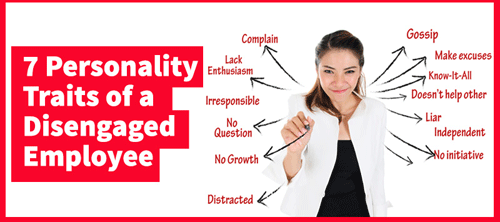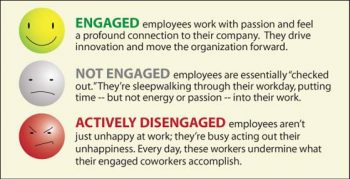Management Matters
7 Personality Traits of a Disengaged Employee
Date Posted: 06/15/2017
Managers and leaders can’t read minds, but good leaders have their fingers on the pulse of their team members and are usually able to tell when performance drops, absenteeism and other chronic problems begin to surface. Strong employer-employee relationship and open lines of communication can bridge the gaps and address declining levels of employee engagement. The underpinnings of employee disengagement can be one or several factors. Knowing who is sinking your boat can make or break the overall success of your team.
Nobody likes to work with zombies, the walking dead or sleepwalkers. Call them what you may, but when that “Uh-oh” moment rears its ugly head and red flags suddenly start to appear, managers are expected to be alert, proactive and effective in resolving conflicts and job performance-related problems caused by a problematic, disengaged staff member. Ward off the workplace zombie apocalypse!
Warning signs can be subtle but sometimes they can be downright discuptive so that a whole team cannot function normally. Here are signs and symptoms that show something is wrong and needs attention.
- ‘Blah’ work quality. People who don’t find meaning and purpose in their work go through the motions. They work mechanically like programmed robots. If employees are left to think that their contribution is insignificant, the quality of their work will show it. Lacklustre, stagnant and uninspired.
- Costly mistakes. Workers who are tuned-out of the work almost always commits errors due to carelessness and lack of attention to details.
- Productivity Drops. Benchmarks and key performance indicators are objective ways to track an employees work output. Dips in productivity or Unproductivity/non-performance/non-improvement (that are not due to reasons beyond employee’s control) are signs that the worker is intentionally getting himself off-tasks and disregarding expectations.
- Poor attendance. Employees who are habitually late or have difficulty showing up for work screams, “I want out!” These employees force themselves out of bed every day and doesn’t have any motivation to show up and get work done. The ones that do manage to pull themselves out of bed and get to the office either sleepwalk, disappear, or go missing-in-action in the middle of a workday.
- Blind meme posts on social media poking fun, being sarcastic, complaining, whining, gossiping and spreading lies about anything work-related without naming anyone is horribly destructive. It is harmful because it causes unjust vexation among co-workers. Unfortunately, the only way they ‘feel’ they are heard is when they are negative and rant and spread negativity publicity.
- Poor Collaboration. Today’s workplace is flooded with collaborative tools that make working in teams and monitoring member productivity easy. A disengaged employee is often distracted and easily goes out of focus. These workers withdraw from the group, leave assigned tasks unattended or makes excuses for incomplete assignments, thereby disrupting the momentum and holding up the team’s progress.
- Unhappy Clients/Customers. When clients start calling to complain about missed deadlines, unanswered calls, emails and unattended concerns, it’s a sure sign that the employee is losing control of relationships. This is one of the reasons why having escalation processes in your company is critical. Disconnected workers lack enthusiasm and tend to drop the ball without even trying, while employees who feel safe and cared for go to great lengths to keep clients happy.
With your ear to the ground and your finger on the pulse, these tell-tale behaviors provide in-the-moment hints that an employee needs a listening ear. Put on your leader’s hat and lenses. Try and see things from the employee’s perspective. One way to build effective teams is to listen to challenges and reach mutually agreeable solutions. Step one is to identify warning signs. Step two is to model and to influence their behavior by mentoring and coaching. While re-kindling and re-igniting employees engagement may not be within your full control all of the time, it is always worth a shot. Employees are our assets. Only after we’ve done our best to polish a rough, uncut stone can we prove that it was, after all, a diamond.
Swifter, surer ways to identify perfect candidates at any level
One of the Philippines’ leading licensed recruitment specialists, Ikon, a human resources company emphasizing on the correct recruitment can help you pinpoint the best candidates for jobs at any level. We offer a refreshingly proactive approach which carefully customizes recruitment activities to your precise needs. Our 18 recruitment centers across the Philippines have helped numerous much over-stretched businesses like yours to fill thousands of vacancies!
If you have any questions, comments or suggestions for future articles, please email us at [email protected]. We regret that replies cannot be addressed individually.
©2017 Ikon Solutions Asia, Inc.
All rights reserved. No part of this article shall be reproduced, stored in a retrieval system, or transmitted by any means, electronic, mechanical, photocopying, recording, or otherwise, without written permission from Ikon. No patent liability is assumed with respect to the use of the information contained herein. Although every precaution has been taken in the preparation of this article, the publisher and author assume no responsibility for errors or omissions. Neither is any liability assumed for damages resulting from the use of information contained herein.
Ikon specifically disclaims any responsibility for any liability, loss or risk, personal or otherwise, which is incurred as a consequence, directly or indirectly, of the use and application of any of the contents of this article.


